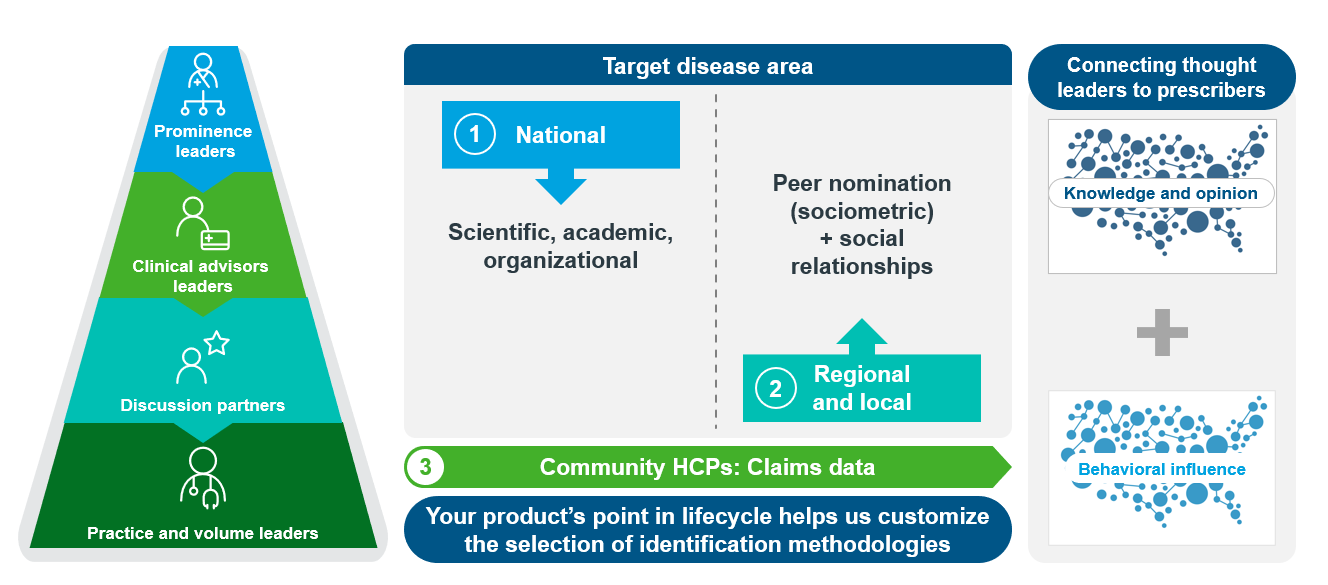















- Locations
- United States
- US Blogs
- Finding the Right Hidden Influencers to Stand Behind Your Product
Healthcare thought leaders have a powerful influence on the underlying beliefs and resulting behavior of those in their communities of practice. When a thought leader adopts a therapy, the rest of the network adopts it at a rate that’s 25% higher than in networks in which a leader doesn’t believe in the value or hasn’t started prescribing the product.
Life sciences companies typically engage thought leaders of national prominence in specific therapy areas as well as high volume prescribers to spread the word about scientific advances. However, there are other important thought leaders between these two groups; those who lead the way clinically and are trusted for their insights but are usually difficult to identify using traditional techniques. Fortunately, by using multiple sources of data and sophisticated analytics (with the aid of artificial intelligence (AI) and machine learning (ML)), we can now identify these hidden influencers.
Four truths about thought leaders
Over the past 18 years, IQVIA has worked extensively with academics and applied our own practical analytics to understand the nature of thought leadership, concluding that:
1. Thought leadership is not monolithic. Different types of thought leaders play different roles in product adoption.
At the national level, there are prominent experts, or key opinion leaders (KOLs). These luminaries create the treatment narrative that frames how, when, and where a product should be used.
Regional influencers are the leaders that translate the science established by the national experts into clinical practice. These influencers are recognized as having a higher level of understanding of the science and have practical clinical experience around a given disease.
A third tier of influencers are discussion leaders, or “near peers,” to whom local healthcare professionals (HCPs) turn to for expert clinical advice via what is often called “curbside consultation.”
The fourth group consists of local advocates who are high-volume prescribers and to whom other HCPs refer patients. Their treatment preferences are often shared by their referral sources.
It is the two groups in the middle (regional clinical advisors and trusted discussion partners) who are often hidden from view but are the lynchpins in accelerating how product information is shared.
2. The impact of thought leaders varies based on the product or service development timeline. The earlier a product is in its lifecycle, the more important scientific/research communities are to it. As development moves toward Phase III, there’s a greater need to identify regional and clinical influence networks. Thus, a product’s point in its lifecycle is the basis for customizing a special selection of data sources and methodologies, and for prioritizing the information uncovered.
3. There are different types of HCP communities of practice. There are scientific networks of physicians who perform research together and co-author scientific papers as well as networks formed around organizations and clinical practice.
4. Different data sources are used to identify thought leaders and align them to the product adoption process. Nationally prominent leaders can be readily identified based on their publications and speaking engagements. Practice and volume leaders can be easily identified using past experience, prescription data, and data on their referrals and shared patients.
Identifying the hidden influencers – the regional clinical advisors and trusted discussion leaders – is often more difficult, and requires sophisticated primary research coupled with big data, and the application of AI/ML. At IQVIA, we’ve developed an advanced ML module that allows us to leverage IQVIA’s big data factory to build relationship insights using a sample gathered from peer nomination data (gathered via primary research) and can predict the connections between the nominated thought leaders and HCPs in the target market. (See Figure 1.)
Figure 1: Combining methodologies to map the entire thought leader landscape

IQVIA’s methodology to inform dynamic targeting
At IQVIA, we’ve developed a comprehensive approach to helping companies leverage thought leader communities (or networks) in their medical and product communications:
- First, we use advanced analytics to identify, profile, and validate thought leaders, and then we align them to the brand strategy, the medical narrative, and the scientific platform.
- We then match those thought leaders to their communities. We have a vast amount of secondary data that allows us to see who initiates prescriptions and who follows their lead. We can map target HCPs to thought leader segments to generate very comprehensive sub-networks or communities of practice. This gives us a complete topology of thought leaders and their communities to understand their common affiliations and common interactions.
- Then, we align leader segments and their practice networks to those internal users who will be engaging with thought leaders. Each type of persona in the company has different types of specific engagements at their disposal.
- Lastly, we orchestrate engagement, delivering personal and non-personal omnichannel campaigns and measuring their impact.
Life sciences companies have long recognized the value of KOLs and high prescribers to their products’ success, but they’ve been unable to connect all the dots of influence within and between HCP communities. Through new analytical methods, it’s now possible to map the entire topology of thought leaders and their communities to accelerate brand uptake.

Identifying and Engaging the Hidden Influencers of Medical Practice: Those That Translate Science into Practice
Healthcare thought leaders have a powerful influence on the behavior of those in their communities of practice, at a rate that’s 25% higher than networks without peer recognize thought leaders.
Learn how IQVIA, with the aid of artificial intelligence and machine learning, can identify hidden influencers; those who lead the way clinically and are trusted for their insights.




